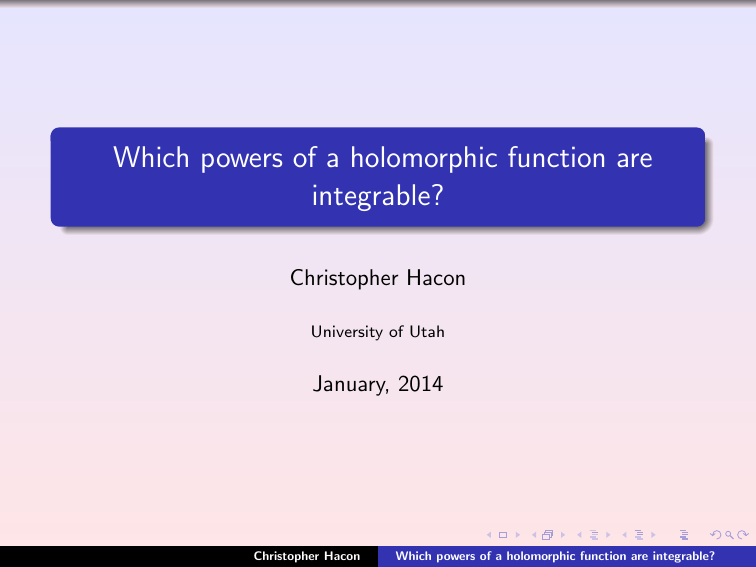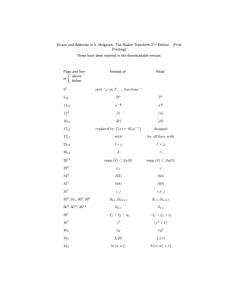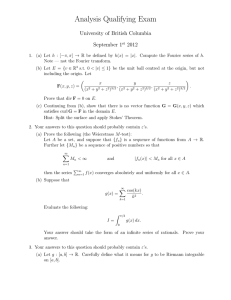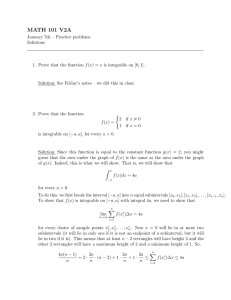Which powers of a holomorphic function are integrable? Christopher Hacon January, 2014
advertisement

Which powers of a holomorphic function are
integrable?
Christopher Hacon
University of Utah
January, 2014
Christopher Hacon
Which powers of a holomorphic function are integrable?
The question
Let p ∈ Cn and f (z1 , . . . , zn ) ∈ C[z1 , . . . , zn ]. For which
values s ∈ R is |f |s integrable on a neighborhood
p ∈ U ⊂ Cn ?
It is clear that |f |s is integrable for all s ≥ 0, however, when
s = −t < 0, then |f1|t may fail to be integrable near the zeroes
of f i.e. the poles of f1 .
It is easy to see that if
t0
1
|f |t
is integrable then so is
1
|f |t 0
for
≤ t.
Definition
The log canonical threshold of f at p, c = lctp (f ) is the
supremum of the numbers s ∈ R≥0 such that |f |−2s is integrable
on a neighborhood p ∈ U ⊂ Cn . (It follows that |f |−2s is not
integrable near p if s > c and integrable if s < c.)
Christopher Hacon
Which powers of a holomorphic function are integrable?
The log canonical threshold
By convention lctp (0) = 0.
Note that if u(p) 6= 0, then
neighborhood p ∈ U ⊂
Cn
1
|f |t
is integrable on a
iff so is
1
|uf |t .
Thus the log canonical threshold lctp (f ) is determined by the
zero set Z = {f = 0} ⊂ Cn (must count zeroes with
multiplicity).
We then let lctp (Z ) = lctp (f ).
Note lctp (Z ) < +∞ iff p ∈ Z .
The log canonical threshold is a natural sophisticated
invariant of the singularities of Z at p which appears in a
variety of contexts (Kahler Einstein metrics, Bernstein-Sato
polynomial, Arnold’s complex singular index,...).
It also naturally generalizes to pairs (X , B) (more about this
later) and hence plays an important role in the minimal model
program.
Christopher Hacon
Which powers of a holomorphic function are integrable?
Some examples
lctO (1/z) = 1. To see this we work in polar coordinates ρ, θ
and note that
Z Z 2π
Z Z
1
2π
1
dVol
=
ρdθdρ
=
dρ
2t
2t
2t−1
|z|
ρ
0
0
0 ρ
which is integrable iff t < 1.
Similarly if p ∈ Z and Z is smooth at p, then lctp (Z ) = 1.
P
More generally, if Z =
bi Zi where Zi are smooth
P
codimension one subvarieties meeting transversely (i.e.
Zi
has simple normal crossings) and bi ∈ Z>0 (i.e. Z is an
effective Z-divisor), then lctp (Z ) = min{ b1i }.
Let HT n be the set of all possible n-dimensional log canonical
(Hypersurface) T hresholds, then HT 1 = {0, 1, 21 , 13 , . . .} as
f = 0, z, z 2 , z 3 , . . . (we always assume f (p) = 0).
We would like to understand HT n for n ≥ 2.
Christopher Hacon
Which powers of a holomorphic function are integrable?
HT n
HT 2 is completely understood by work of Varchenko.
It seems too difficult (and maybe not so important) to
completely determine HT n for n ≥ 3.
It is known that HT n ⊂ [0, 1] ∩ Q (we assume p ∈ Z ) and
∪n≥1 HT n = [0, 1] ∩ Q.
Never-the-less the sets HT n have some remarkable structure
(first investigated by Shokurov) which is useful in applications.
We begin by explaining how LCT’s are computed in practice
and giving some examples.
Christopher Hacon
Which powers of a holomorphic function are integrable?
An interesting example
Consider f = y 2 − x 3 . We use the substitution x = uv 2 and
y = uv 3 .
The integral of 1/|f |2t is then computed by integrating
|uv 4 |2
1
1
1
=
· 12t−8 ·
2
6
3
6
2t
4t−2
|u v − u v |
|u|
|v |
|1 − u|2t
Here, |uv 4 |2 is the Jacobian of our change of variables and
1
ϕ = |1−u|
2t is a unit (ϕ(O) 6= 0) and so it can be ignored.
But u · v = 0 has simple normal crossings, so the integrability
condition is just 4t − 2 < 2 and 12t − 8 < 2 i.e. t < 5/6.
As lct(cusp) = 5/6 < lct(node) = 1, the cusp is more
singular than the node.
Log resolutions give a more geometric interpretation.
Christopher Hacon
Which powers of a holomorphic function are integrable?
Log resolutions
A log resolution is a change of variables such that both the
Jacobian and the set f = 0 correspond to simple normal
crossing divisors (and hence the LCT is easy to compute).
More precisely we have a map ν : X → Cn s.t. the zeroes of
Jac(ν) and ν ∗ (f ) = f ◦ ν have simple normal crossings.
We denote by KX /Cn is the divisor corresponding to the
(complex) Jacobian.
In local coordinates
ν ∗ (dz1 ∧ . . . ∧ dzn ) = (unit)x1k1 · · · xnkn dx1 ∧ . . . ∧ dxn
P
and so KX /Cn =
ki Ei where Ei = {xi = 0}.
Christopher Hacon
Which powers of a holomorphic function are integrable?
Log resolutions
By a deep result of Hironaka, log resolutions always exist and
are given by a finite sequence of blow ups along smooth
centers.
Eg. the blow up of Cn at the O is obtained by replacing O
with a copy of Pn−1 = (Cn \ O)/C∗ (each point in Pn−1 is a
tangent direction at O ∈ Cn ).
Pn−1 is covered by charts An−1
; given [y0 : . . . : yn−1 ] ∈ Pn−1 ,
i
if yi 6= 0 then φi [y0 : . . . : yn−1 ] = ( yy0i , . . . , yyˆii , . . . , yyni ) ∈ An−1
.
i
Eg. P1 is covered by two copies of C glued together via
φ(z) = 1/z.
Christopher Hacon
Which powers of a holomorphic function are integrable?
P1C
Christopher Hacon
Which powers of a holomorphic function are integrable?
tJvJ
fl\
‘I
&
->4
S
Christopher Hacon
U
-fr
—
-t
>
>
0—
><
ci—
9
t-)
-.
(
L
0
—
-+•
ri
0
(N
>
tJ
Blow ups
Which powers of a holomorphic function are integrable?
Log resolutions and LCT’s
1/|f |2t is locally integrable at p iff |Jac(f )|2 /|ν ∗ (f )|2t is
integrable on a neighborhood of ν −1 (p).
We assume that ν −1 (p) is compact and so it is enough to
check that |Jac(f )|2 /|ν ∗ (f )|2t is locally integrable at every
point of ν −1 (p).
P
If we denote KX /Cn = P ki Ei the divisor
P given by the zeroes
of Jac(ν) and µ∗ Z = ai Ei , then as
Ei is simple normal
2
∗
2t
crossings, |Jac(ν)| /|ν (f )| is locally integrable iff
tai − ki < 1 for all i (assuming p ∈ µ(Ei ), ∀i). Thus
lctp (f ) = min{
Christopher Hacon
ki + 1
} ∈ Q.
ai
Which powers of a holomorphic function are integrable?
Log resolution of the cusp
—3,
41
—74
2/
9
+
2
-c: 7
L(
:_7
/i
Christopher Hacon
Which powers of a holomorphic function are integrable?
Multiplicity vs LCT
Note that blowing up p ∈ Cn yields an exceptional divisor E
with k = n − 1 and a = multp (f ), thus lctp (f ) ≤ n/multp (f ).
On the other hand it is not too hard to show that if f (p) = 0,
then lctp (f ) ≥ 1/multp (f ).
We have lctO (z1a1 + · · · + znan ) = min{1, a11 + · · · +
(generalizes lctO (z12 + z23 ) = 12 + 13 = 65 ).
1
an }
In particular ∪n≥1 HT n = [0, 1] ∩ Q.
More generally,
lctp (f (x) ⊕ g (y )) = min{1, lctp (f (x)) + lctp (g (y ))}.
So lctp (f (x1 , . . . xn−1 ) + y m ) = lctp (f (x1 , . . . xn−1 )) +
1
m.
Thus the set of accumulation points of HT n contains HT n−1 .
Christopher Hacon
Which powers of a holomorphic function are integrable?
The structure of HT n
The structure of HT n was understood by de Fernex-Mustata,
Kollár and de Fernex-Ein-Mustata. This gives a positive answer to
a conjecture of Shokurov.
Theorem (dFEMK)
• The set HT n satisfies the ACC (ascending chain condition) so
that any non-decreasing sequence is eventually constant.
• The accumulation points of HT n are given by HT n−1 \ {1}.
In particular there is a biggest element 1 − n in [0, 1) ∩ HT n .
Conjecturally this is computed as follows.
Let c1 = 1, cn+1 = c1 · · · cn + 1 so
ci = 2, 3, 7, 43, 1807, 3263443, . . .. Then
n
1 − n = 1 −
X 1
1
=
= lctO (z1c1 + · · · + zncn ).
c1 · · · cn
ci
i=1
Christopher Hacon
Which powers of a holomorphic function are integrable?
Proof of the theorem of dFEMK
The proof relies on two main ingredients: generic limits and
m-adic approximation.
Suppose that we have a sequence of fi s.t. lctp (fi ) is non
decreasing, then we must show it is eventually constant.
The main idea is to find an accumulation point fi → f∞ , such
that (passing to a subsequence) we may assume that
1) lim lctp (fi ) = lctp (f∞ ) (generic limits) and
2) lctp (fi ) = lctp (f∞ ) for all m 0 (m-adic approximation).
Since C[z1 , . . . , zn ] is infinite dimensional, it is not clear that
these accumulation points/limits exist.
Christopher Hacon
Which powers of a holomorphic function are integrable?
Proof of the theorem of dFEMK
Assume that p = O = (0, . . . , 0) ∈ Cn and let τ<m (f ) denote
the truncation of f (Taylor polynomial of degree ≤ m − 1).
It is not hard to see that |lctO (fi ) − lctO (τ<m (fi ))| ≤
(continuity of LCT’s).
n
m
C[z1 , . . . , zn ]/(z1 , . . . , zn )m is finite dimensional and the
zeroes of τ<m (fi ) are determined by a point in the compact
space PNm = P(C[z1 , . . . , zn ]/(z1 , . . . , zn )m ).
Therefore, after passing to a subsequence, we may assume
that τ<m (fi ) converges to ”τ<m (f∞ )”.
Repeating this for bigger and bigger m and passing to further
subsequences, we obtain the required f∞ .
Unluckily, this choice of f∞ is not good because we may have
lim (lctO (fi )) 6= lctO (f∞ ).
i→∞
Christopher Hacon
Which powers of a holomorphic function are integrable?
Semicontinuity
For example if fi (x) = x 2 + 1i x, then f∞ (x) = x 2 and so
lctO (fi ) = 1 but lctO (f∞ ) = 1/2.
The problem is that LCT’s are are semicontinuous in the
Zariski toplology: they are constant on open subsets and
jump down on closed subvarieties defined by polynomial
equations (i.e. acquire worse singularities).
Another example ft (x, y ) = y 2 − x 3 + tx 2 . For t 6= 0 we have
a node and hence lctO (ft ) = 1 but for t = 0 we have a cusp
and hence lctO (ft ) = 5/6.
The proper closed subsets in the Zariski toplology are given by
zeroes of polynomial equations (and hence are finite unions of
hypersurfaces).
In particular, the proper closed subsets of C consist of finitely
many points and hence {1 − 1i |i > 0} = C.
Christopher Hacon
Which powers of a holomorphic function are integrable?
Generic accumulation points
We instead consider Zm an irreducible component of the
Zariski closure of {τ<m (fi )}i>0 ∈ P(C[z1 , . . . , zn ]/mm ) and gm
a very general point of Zm . (Here m = (z1 , . . . , zn ).)
Passing to a subsequence, we have τ<m (fi ) ∈ Zm for all i ≥ m.
We then choose Zm+1 so that its image is dense in Zm and
hence gm+1 a very general point of Zm+1 s.t.
gm = τ<m (gm+1 ).
We thus obtain the compatible sequence {gm }m>0 and hence
the generic limit g∞ ∈ C[[z1 , . . . , zn ]] s.t. gm = τ<m (g∞ ) for
any m > 0.
By construction, we have lctO (gm ) = lctO (τ<m (fm )) for all m.
Then by continuity of LCT’s and construction of gm , we have
lctO (g∞ ) = lim lctO (gm ) = lim lctO (τ<m (fm )) = lim lctO (fm ).
m→∞
m→∞
Christopher Hacon
m→∞
Which powers of a holomorphic function are integrable?
m-adic approximation
We must show that we can remove the limits in the sequence
of equalities
lctO (g∞ ) = lim lctO (gm ) = lim lctO (τ<m (fm )) = lim lctO (fm ).
m→∞
m→∞
t→∞
It turns out that if we assume that the sequence lctO (fm ) is
non decreasing, then lctO (g∞ ) is computed by an exceptional
divisor E over O and so we can apply the following.
Theorem (m-adic approximation)
If lctO (g ) is computed by a divisor E over O then
lctO (τ<m (g )) = lctO (g ) for all m 0 (in fact m ≥ valE (g )).
Thus lctO (g∞ ) =m0 lctO (gm ) = lctO (τ<m (fm )) =m0 lctO (fm ).
Christopher Hacon
Which powers of a holomorphic function are integrable?
m-adic approximation
The proof of m-adic approximation relies only of resolution of
singularities and the Kollár-Shokurov Connectedness Theorem
which dates back to 1992 and is (by now) a standard
consequence of Kodaira-Kawamata-Viehweg vanishing.
The Connectedness Theorem implies that if ν : X → Cn is a
log resolution P
of (Cn , f ), and λ > 0 then the non log
canonical set λai −ki ≥1 Ei is connected over O.
Christopher Hacon
Which powers of a holomorphic function are integrable?
Kollár-Shokurov Connectedness
1
4
toy-
Christopher Hacon
Which powers of a holomorphic function are integrable?
(—C
\1
Li.
‘4
çZ
1
0
Christopher Hacon
1
C-.
V
c
1-
C-.
c-.
S
t.
c
-t
0
-
Li,
Li.
N
-b
H
-1-
I—’
—
-4-
\f\
0
jC
m
.1
)c
S.—
C’,
0
11
-
r-1
rn
i’
C’—
C’
-ci
-1--
(5,
1’
0
(N
I
-1-
0
m-adic approximation
Which powers of a holomorphic function are integrable?
Further results
The method of de Fernex, Ein, Mustata, Kollár generalizes to
studying LCT’s on varieties with bounded singularities
(defined by equations of bounded degree).
This is still too restrictive for most applications. However
using the full strength of the MMP, Hacon-Mc Kernan-Xu
prove the analog for log canonical pairs.
Christopher Hacon
Which powers of a holomorphic function are integrable?
Log pairs
The easiest example of log canonical pair (X , B) is given by
X a smooth
manifold (defined by polynomial eqn’s) and
P
B=
bi Bi a simple normal crossings divisor with coefficients
0 ≤ bi ≤ 1.
In general we allow X to be mildly singular in codimension
≥ 2 (X is normal) and we let KX be the canonical divisor. It
corresponds to the zeroes of a section of ωX (the line bundle
locally defined on the smooth locus by dx1 ∧ . . . ∧ dxn ).
We also require that KX + B is R-Cartier i.e. is an
R-combination of divisors defined by rational functions (in
particular KX + B pulls-back to log resolutions).
Then (X , B) is log canonical if for any resolution ν : Y → X ,
with KY + BY = ν ∗ (KX + B), the coefficients of BY are ≤ 1.
The Jacobian (or KY /X ) corresponds to the difference between
dx1 ∧ . . . ∧ dxn and dy1 ∧ . . . ∧ dyn , i.e. to KY − ν ∗ KX .
Christopher Hacon
Which powers of a holomorphic function are integrable?
Christopher Hacon
—c
‘I
çjD
0
z
r
4
Examples of log canonical pairs
Which powers of a holomorphic function are integrable?
Generalization to log pairs
Fix a DCC set I ⊂ [0, 1] (DCC means that any non increasing
sequence is eventually constant; eg. I = {1 − n1 |n ∈ N}).
P
If (X , B) is log canonical and M = mi Bi is R-Cartier with
mi ∈ N, then define
lct(X , B; M) = sup{t ∈ R|(X , B + tM) is log canonical}.
In the SNC case this just means that bi + tmi ≤ 1.
Let Tn (I ) be the set of all such lct(X , B; M). Then:
Theorem (Shokurov’s ACC for LCTs Conjecture (H-M-X))
• For any positive integer n, the set Tn (I ) satisfies the ACC.
• If Ī = 1, then Tn (I ) = Tn (I ) \ 1.
i
In the SNC case Tn (I ) = { 1−b
mi |bi ∈ I , mi ∈ N}.
Christopher Hacon
Which powers of a holomorphic function are integrable?
Shokurov’s ACC for LCTs Conjecture
Unluckily the proof uses all of the recent result of the minimal
model program due to Birkar, Cascini, Hacon, Mc Kernan, Siu,
Xu and others.
The main idea is to rephrase the local problem as a global one.
Suppose that the the singularity
P p ∈ (X , B) is a cone over a
1-dimensional pair (C , P =
pi Pi ), then
P (X , B) is log
canonical iff vol(KC + P) := 2g − 2 + pi ≤ 0.
Not suprisingly, for bigger g and pi we get worse singularities.
Similarly, questions about the singularities (LCT’s) of (X , B)
can be rephrased in terms of global properties of (C , P).
Christopher Hacon
Which powers of a holomorphic function are integrable?
Global to local
Using techniques from the minimal model program [BCHM],
we show that the LCT’s at p ∈ (X , B) are measured by an
ν
exceptional divisor E ⊂ Y → X (this is the analog of blowing
up the vertex of a cone).
If λi = lctpi (Xi , Bi ; Mi ) is an increasing sequence with limit λ,
then by adjunction one considers (Ei , Pi ) where
−1
(Bi + λMi ))|Ei .
KEi + Pi = (KYi + Ei + νi,∗
If n = dim E , then
vol(KE + P) = lim
dim H 0 (m(KE + P))
> 0.
mn /n!
We then prove the corresponding result for volumes (instead
of LCT’s).
Christopher Hacon
Which powers of a holomorphic function are integrable?
Log boundedness
Theorem (Hacon-Mc Kernan-Xu)
Fix n ∈ N, I ⊂ [0, 1] a DCC set, then there is a constant M > 0
such that if V = {vol(KX + B)} where (X , B) are log canonical
pairs, dim X = n and the coefficients of B are in I , then V satisfies
the DCC (and in particular has a positive minimum).
P
1
Eg. if dim X = 1 and B = bi B
Pi , bi ∈ {1 − m |m ∈ N}, then
V = {vol(KX + B) = 2g − 2 + bi } is a DCC set with positive
1
minimum 42
.
Christopher Hacon
Which powers of a holomorphic function are integrable?
Refs
Thanks to NSF and Simons Foundation for generous support.
Useful references:
Limits of log canonical thresholds – de Fernex-Mustata, Ann.
Sci. École Norm. Sup. 42 (2009), 493-517
Which powers of holomorphic functions are integrable?. –
Kollár – arXiv:0805.0756
Log canonical thresholds on varieties with bounded
singularities – Ein-de Fernex-Mustata, ”Classification of
algebraic varieties-Schiermonnikoog 2009” C. Faber, G. van
der Geer, E. Looijenga editors, EMS Ser. Congr. Rep., Eur.
Math. Soc., Zrich, 2011
ACC for log canonical thresholds – Hacon-McKernan-Xu –
arXiv:1208.4150
Christopher Hacon
Which powers of a holomorphic function are integrable?






